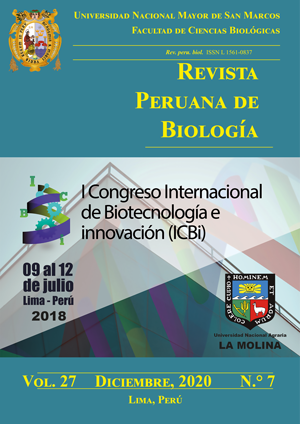Single molecule sequencing of nucleic acids in real time (SMRT) to characterize transcriptomes and mRNA isoforms
DOI:
https://doi.org/10.15381/rpb.v27i1.17585Keywords:
SMRT sequencing, Next generation sequencing, X-degenerate genes, Y-ChromosomeAbstract
Our efforts are oriented to assess bovine Y-chromosome gene expression patterns. One set of genes that are of interest are the so-called X-degenerate Y-chromosome genes that are located in the male-specific region of the Y-chromosome (MSY). This region contains 95% of the DNA of the Y chromosome. These genes are single copy and have an X-chromosome homolog. Both, the Y-encoded and X-encoded homologs have ubiquitous expression profiles. However, some genes, like SRY that regulates male sex determination, have functions that are more specific. Identifying DNA sequence differences between these homologs will allow evaluation of their spatial and temporal expression patterns. Identification of the Y-encoded mRNAs and their isoforms will allow our understanding of tissue specific expression of isoforms in male tissues. The latter will facilitate our evaluation of gene function in male sex differentiation and fertility. Hence, we hypothesized that each of these X-degenerate gene homologs generate isoforms and that differential expression patterns exist between sexes and across tissues. To investigate the latter we used a new generation sequencing (NGS) technology that generates long sequencing reads with a range between 1000 to 10,000 base pairs in length. Single molecule real time (SMRT) isoform sequencing (IsoSeq) of several tissues (liver, lung, adipose, muscle, hypothalamus and testis) was carried out. Transcript sequences were used for bioinformatics analysis and isoform characterization. Given the focus of this manuscript the SMRT technology we are only presenting results obtained with the analysis of the bUTY and bUTX genes.
Downloads
Downloads
Published
Issue
Section
License
Copyright (c) 2020 F. Abel Ponce de León, Guo Yue, Brian Crooker

This work is licensed under a Creative Commons Attribution-NonCommercial-ShareAlike 4.0 International License.
AUTHORS RETAIN THEIR RIGHTS:
a. Authors retain their trade mark rights and patent, and also on any process or procedure described in the article.
b. Authors retain their right to share, copy, distribute, perform and publicly communicate their article (eg, to place their article in an institutional repository or publish it in a book), with an acknowledgment of its initial publication in the Revista Peruana de Biologia.
c. Authors retain theirs right to make a subsequent publication of their work, to use the article or any part thereof (eg a compilation of his papers, lecture notes, thesis, or a book), always indicating its initial publication in the Revista Peruana de Biologia (the originator of the work, journal, volume, number and date).






